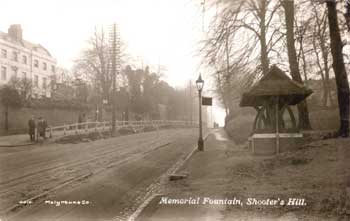History of Shooters Hill
Shooters Hill is the highest point in South London (432ft) and a wonderful viewpoint into adjacent counties.
Although the Roman Road (Watling Street), later the Canterbury Way, from Dover to London passes over the summit of the hill it was always a place to be feared by travellers. High and isolated with few dwellings and thick woodland the traveller was always vulnerable to attack by highwaymen and footpads. The place name "Hill or slope of the shooter or archer", first recorded in 1226, may have its origins in these long-standing criminal associations.
It was, however, a place of burial for the early inhabitants of the Plumstead district. A burial ground of possibly Bronze Age date was on the northern side of the summit. Of these burials only one survives in Brinklow Crescent and another, probably related, on Plumstead Common.
The development of Shooters Hill began in the 18th century although the Catharine Wheel Inn could possibly date back to the early years of the 17th century. A spa town was even proposed in the mid 18th century because of the many springs that rise on the hill, but nothing came of it.
Many fine houses had been built by the end of the 18th century including Shrewsbury House where Princess Charlotte, daughter of George IV, stayed in 1799. The present Shrewsbury House was built in 1926 on a site adjacent to the original mansion.
In Castlewoods on the south side of the hill is the curious folly, Severndroog Castle, designed by Richard Jupp in 1784 for Lady James as a memorial to her husband Sir William James who captured the fortress of Severndroog on the Malabar Coast in India in 1755.
The thick woodland on Shooters Hill was seriously threatened by housing developments in the 20th century. Suburban housing had already spread over much of the farmland at the foot of the hill in Welling, Plumstead and Kidbrooke. Fortunately for later generations the London County Council was able to acquire as public open spaces Castle Wood and Severndroog Castle in 1922, Jackwood in 1923, and Oxleas Wood in 1934.
From 1985 to 1993 a large area of Oxleas Wood and Woodlands Farm was threatened by the East London River Crossing road scheme. Fortunately, the proposal was abandoned in 1993 following a European Court decision the previous year.
Woodlands Farm, a remarkable survival, on the Welling side of the hill is now a flourishing community farm with sheep, cows, and horses grazing in fields bordered with ancient hedgerows.






